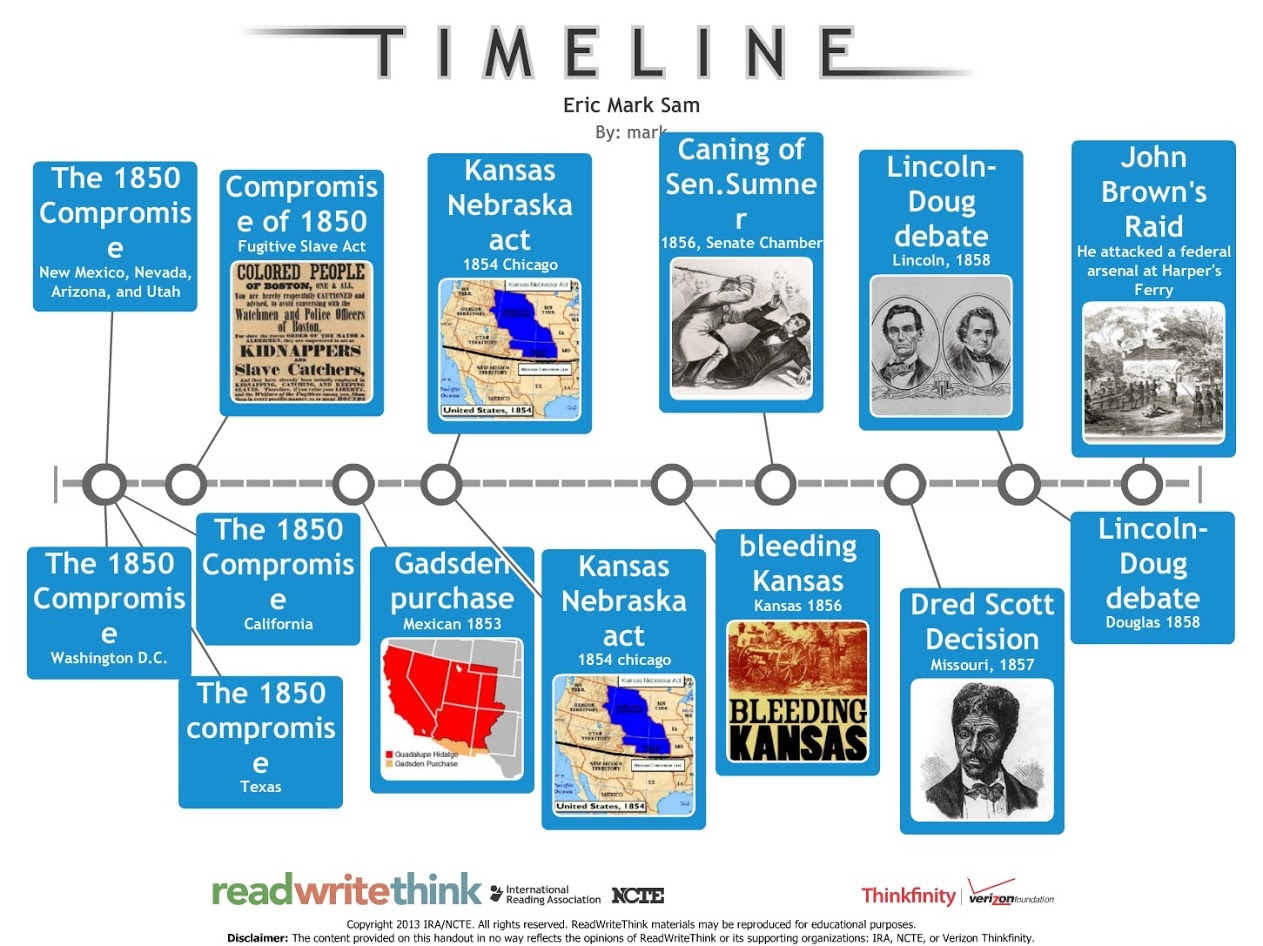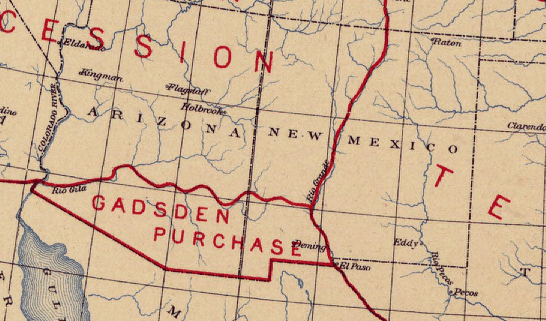 Slavery was a major part in the United States in the early 19th century, and created much tension between the north and south due to differing beliefs regarding the topic. Due to this tension, several events (based in the argument of slavery) occurred leading up to the civil war. In class, we made a timeline of these events, placing those which were anti-slavery above the line and pro-slavery below the line. A conclusion can be made that during this time, slavery was the “elephant in the room”, due to the events which took place and the motivations with which they were fueled.
Slavery was a major part in the United States in the early 19th century, and created much tension between the north and south due to differing beliefs regarding the topic. Due to this tension, several events (based in the argument of slavery) occurred leading up to the civil war. In class, we made a timeline of these events, placing those which were anti-slavery above the line and pro-slavery below the line. A conclusion can be made that during this time, slavery was the “elephant in the room”, due to the events which took place and the motivations with which they were fueled.

The Compromise of 1850 was a result of the tension between the north and south regarding slavery, with both sides arguing for their cause and what was viewed as “equal”. The compromise occurred as a result of the Missouri Compromise of 1820, along with the gold rush to California. After the Missouri Compromise balanced the number of slave states and free states, the gold rush complicated matters. Due to its growing population, California requested to become a free state; as there was already a balance between the number of slave and free states, California would only undo what had been done in the past. Due to this, the five-part Compromise of 1850 was created. In the Compromise, there were two portions which were anti-slavery, and three which supported slavery. The first part of the Compromise which opposed slavery stated that the slave trade would be illegal in Washington D.C., while slavery itself would still remain legal. In addition to this, the Compromise also stated that California would be a free state. The first pro-slavery part of the compromise was for Texas to be paid $10 million in exchange for some land, but with this money it would be able to pay off its debt to Mexico. With this, the territories of New Mexico, Nevada, Arizona and Utah would be organized without slavery mentioned. As these territories are in the southwest portion of the country, they would be surrounded with slavery advocates and most likely be influenced by them. The last part of the Compromise was added in order to counteract the imbalance created by the admission of California as a free state; the Fugitive Slave Act. This required the common people to assist in the recovery of fugitive slaves. With this, slaves would not have the rights to a jury trial.
 |
|
A couple years earlier, in the treaty of Guadalupe Hidalgo, the United States paid $15 million for a region consisting of Nevada, California, Utah, Arizona and New Mexico. Five years later, a much smaller plot of land was purchased for $10 million dollars; this land was known as the Gadsden Purchase. With this land, the U.S. planned to build a transcontinental railroad, which would give those in the south easier access to the west. This event was one which supported slavery due to the location of the railroad. It would make it easier to move slaves, as well as pro-slavery citizens, to the west and new parts of the country.
Four years after the Gadsden Purchase, Dred Scott, an enslaved man living in Missouri, sued his owner. He and his wife Harriet made the argument that they were free, due to previously living in a state in which slavery was illegal. The case made it to the Supreme Court, where a 7-2 ruling was made against the Scotts’. With this ruling came three lasting effects which had a great impact on slaves. One was that slaves could no longer sue in court, due to not being citizens of the country. The second was that slaves could not win freedom by simply moving to or living in a free state or territory, which hurt movements such as the underground railroad which had previously relied on this principle. Lastly, the Missouri Compromise of 1820 was ruled unconstitutional. Due to this, slavery was no longer illegal, in any state. The ruling, and the three effects that came of it were all pro-slavery, and hurt slaves’ chances for freedom in the future.
A final event which exhibited the tensions between the north and the south was John Brown’s Raid at Harper’s Ferry, Virginia. John Brown attacked the federal arsenal there, hoping to seize the weapons and give hope to the enslaved that they could rebel against their captors. Brown and his followers had hopes of ending slavery and bringing a moral renewal to the states. However, the raid was unsuccessful, and Brown was hanged because of his role in the attack. With his death, racial tension was further revealed through the reaction to Brown’s death. Northerners hailed Brown as a martyr of justice, while southerners were outraged and denounced him as a criminal who had tried to spark a rebellion.
All of the previously mentioned events were fueled by the racism in the United States at the time; however, the fact that nothing major happened after these events proves that it was not being fully discussed in government for its physical implications and the dangerous things that were happening in society. Because of this, it can be viewed as the “elephant in the room”.
 Pre Civil War, the United States was filled with tension revolving around the topic of slavery. Views on the topic changed by region, which can be seen in the results of the presidential election of 1860. As can be seen in the image to the right, the Northwest and West supported Lincoln, while the South supported Breckinridge. Lincoln was against slavery while Breckinridge believed there should be no laws against slavery. This clearly shows the division of beliefs, from antislavery views in the North to pro-slavery views in the South. Apart from those two candidates, however, Missouri supported Douglas. Missouri would support Douglas because of their geographic proximity to Kansas and Nebraska, with Douglas’ support of popular sovereignty. These people believed in popular sovereignty and wanted to make decisions based on slavery for themselves. Lastly, the border states (Tennessee, Kentucky, West Virginia and Virginia) supported Bell. Bell believed in keeping the country the same as it was, with no major changes made to the system. The people of the border states supported this viewpoint because they didn’t want to be in the middle of any fighting between the north and south that would come of attempts to make change.
Pre Civil War, the United States was filled with tension revolving around the topic of slavery. Views on the topic changed by region, which can be seen in the results of the presidential election of 1860. As can be seen in the image to the right, the Northwest and West supported Lincoln, while the South supported Breckinridge. Lincoln was against slavery while Breckinridge believed there should be no laws against slavery. This clearly shows the division of beliefs, from antislavery views in the North to pro-slavery views in the South. Apart from those two candidates, however, Missouri supported Douglas. Missouri would support Douglas because of their geographic proximity to Kansas and Nebraska, with Douglas’ support of popular sovereignty. These people believed in popular sovereignty and wanted to make decisions based on slavery for themselves. Lastly, the border states (Tennessee, Kentucky, West Virginia and Virginia) supported Bell. Bell believed in keeping the country the same as it was, with no major changes made to the system. The people of the border states supported this viewpoint because they didn’t want to be in the middle of any fighting between the north and south that would come of attempts to make change.